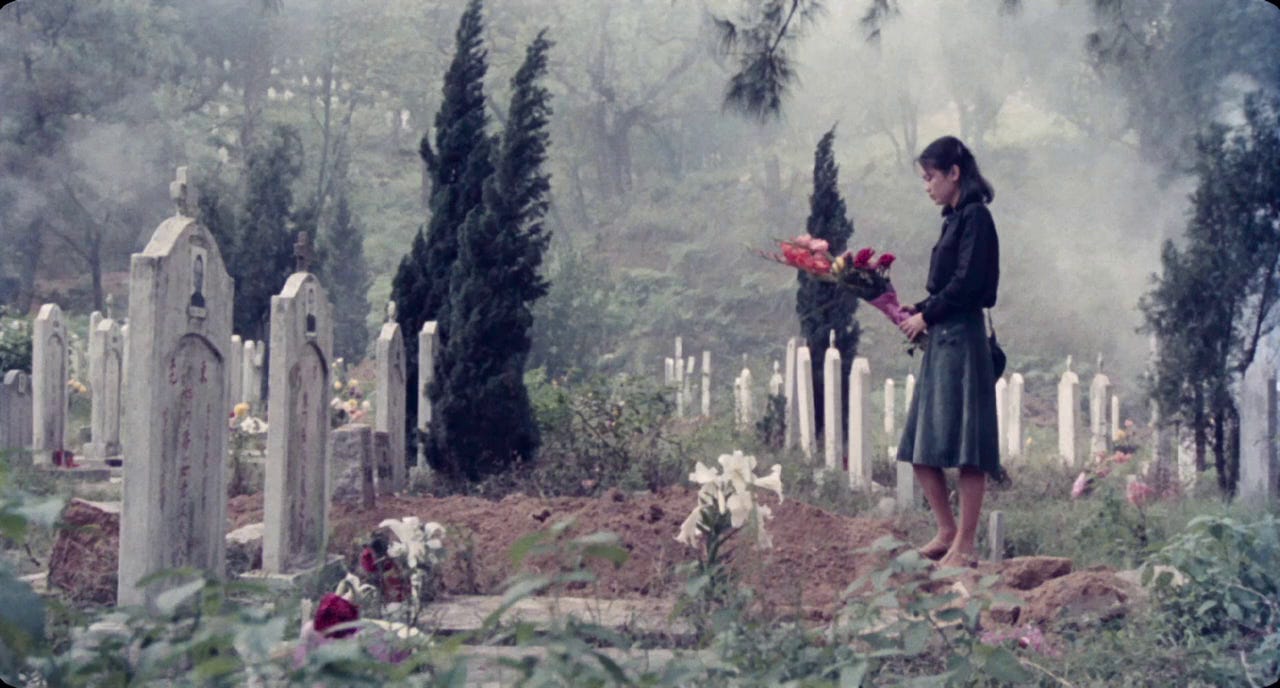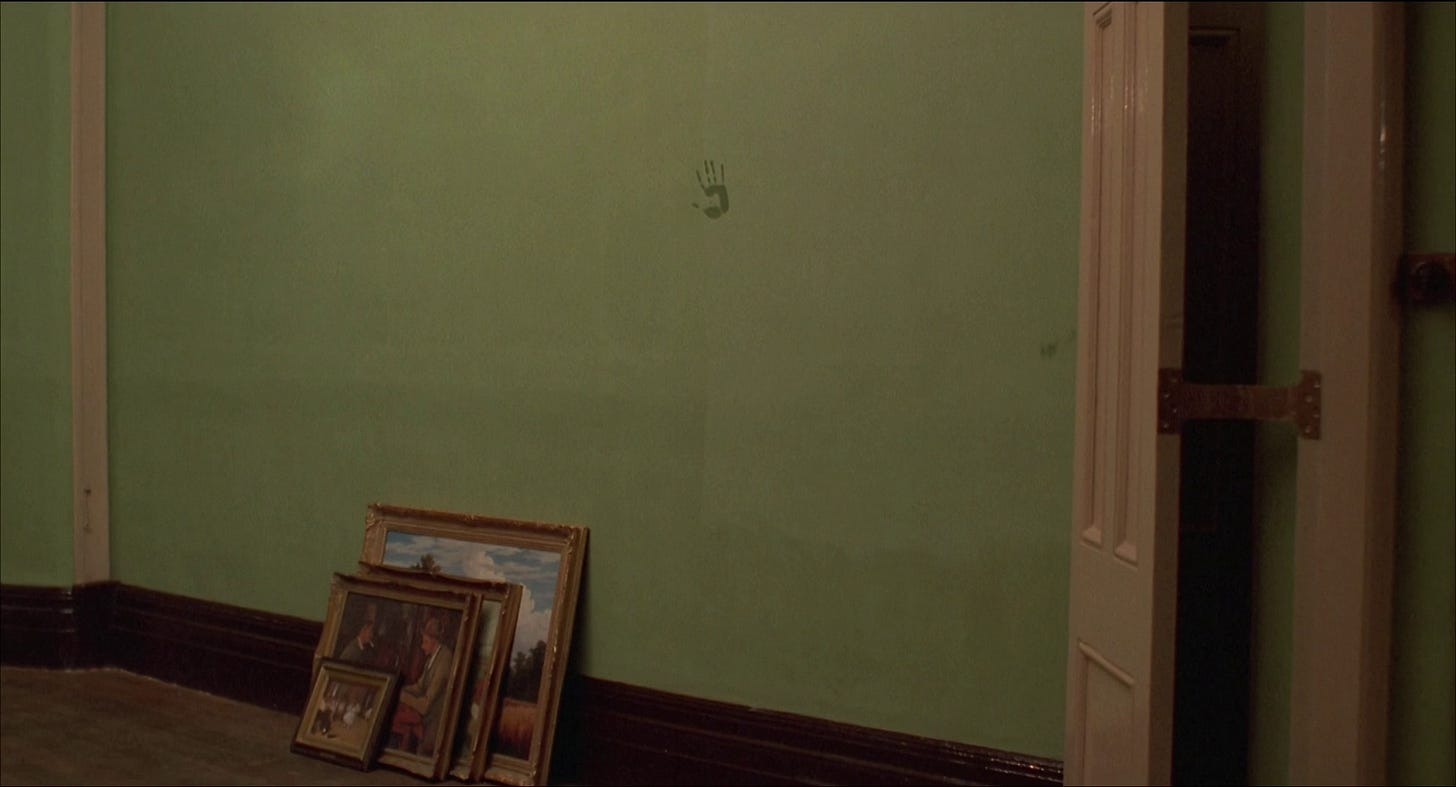
Mass for the Dakota Sioux (Bruce Baillie, 1965)
A figure face down on the street, if we look carefully in the darkness, we can see a man come upon the scene before turning away; has he seen the body or the camera? From this we are launched into a cacophonous image build up of the American empire: Factories, cities, bridges, endless rows of identikit housing, parades, war, ‘commercials’, sports, shoppers. The sheer mass of culture hard to comprehend, and all of it predicated on an eradication of indigenous culture, land and peoples now possibly unknowable to us. It’s a sequence remarkably powerful, an abstract communication of the loss of centuries of history across a continental landmass. Many of the images are blurred and indistinct. Some ruptured by blinding light. Either overexposed or simply presented in negative. A dissociative response of the brain to the scope of images and information it is simply unable to process.
Nonetheless, one can find their own reflections emerging in the work. A brief glimpse of a child at a writing desk. one armed curled around its perimeter hiding the action of his other, a fevered spectre of the Residential Schools. At one point, some cries begin to emerge in the sound mix. There is a semblance of trumpeting music underneath. We’re not sure if it’s the sound taken from a western film or merely the sound of the football playing on TV. The abstraction of genocide into mass market spectacle. Beyond two quotes presented at the beginning and midway through the short there is no direct depiction of Native American peoples or culture. Thus Baillie avoids a direct romanticisation of these communities, an act that is part of colonisation process, not a counter-action. It is a ‘mass’ - a ritual of the colonisers and their culture; it can never be more than this.
After the cacophony we cut to black before form slowly returns and we are again faced with the man face down on the pavement. Strangers look but don’t act. Eventually three figures emerge from behind the camera and kneel before the figure. a white sheet is placed over the body. It is loaded into a vehicle and taken away.

Bruce Baillie, who passed away earlier this year, filmed Mass for the Dakota Sioux in the winter of 1963-64 ; four years before the foundation of AIM, who would begin to bring conversations that had been happening in NA communities for decades in to public attention with a series of protests and radical activities that peaked with a stand off at Wounded Knee, South Dakota; where around three hundred men, women and children of the Lakota tribe had been murdered by a United States Army Cavalry Regiment in 1890. Baillie, born in Aberdeen, South Dakota, on land that had been defrauded from the Anishinaabeg peoples a few decades earlier, shot much of the film is shot around the bay area; an urban sprawl which, sat on the edge of the pacific ocean, represents America’s attainment of its manifest destiny. The pacific seen here is a tempest crashing violently against sparse, jagged rocks. There’s kittle more of America’s natural landscape; an extended shot of a motorcyclist riding across the bay bridge disappears any permanence outside of the bridge and the rider. Only toward the end can we see a few treetops intruding into the bottom of the frame in a shot that captures dark clouds broadly extending over the land.
Five years after the release of ‘Mass…’ Dee Brown published Bury My Heart at Wounded Knee. A book that has remained a seminal text for those wishing to study the destruction of Native American communities at the hands of American expansion for decades. Bury My Heart at Wounded Knee was an elegy. A narrative that ended with the death of Native American culture at the Wounded Knee massacre. This approach has been increasingly criticised by Native Americans, who have sought to emphasise the ongoing existence of their communities and continued struggles into the 20th and 21st centuries. While ‘Mass…’ avoids direct romanticisation it ultimately comes to the same elegiac conclusion as Bury My Heart… . As a work it trusts us to rely on our own experience and connotations to draw truth out from its hurricane of images but perhaps goes inadvertently further by presenting Native American existence as prematurely disappeared.

Four Films by Ann Hui: The Secret (1979), The Story of Woo Viet (1981), Boat People (1982) and Love in a Fallen City (1984)
Four early films by the veteran Hong Kong director, showcase a filmmaker with a knack for deeply felt intimacy deftly reckoning with the island’s local politics and relationship to the outside world.
Drawing on a ripped from the headlines contemporary crime, Hui’s striking feature debut The Secret follows Lin Jeng-ming’s (Sylvia Chang) investigation into the savage murder of her friend Li Yuen and the girls boyfriend Ah-Cho. Lin begins to realise the murders are tied up with the disappearance of a Mui Siu-kei (Hye-suk Lee), a Thai migrant, sex worker and tuberculosis patient Ah-Cho was also involved with. Marked by an alienating editing, particularly in its opening half hour, that blurs between past and present, the direct relations remaining ambiguous. This temporal divide of Hong Kong manifests elsewhere; much of the film takes place in the old fashioned neighbourhood far, it’s cramped alleyways, traditional etiquette and rites contrasted with the brief glimpses we see of Ah-Cho’s professional class family. A class divide emphasised with the development that they were unaware of Li Yeun existence.
Again and again, the incompetence of institutions, corporations, hospitals and the church, becomes apparent. Presented indirectly as Lin attempts to track Mui down through levels of bureaucracy who forgot about her as soon as she left their eyesight. The creeping paranoia, most boldly expressed in the lurking camera movements which duck around corners and behind parked cars, culminates in a moment of hysteria in which we finally view the original assault and a new attack which appears as a reconstruction of the original. Only through this re-enactment, that breaks the linearity of time, can the tension between past and present be resolved.

Migration becomes the focus in The Story of Woo Viet, which follows Woo Viet (Chow Yun Fat),a Vietnamese refugee in Hong Kong, whose hopes for emigration to America see him manipulated into working as a hitman for Chinese gangsters in Manila in the hopes that he will be able to buy freedom for himself and a fellow immigrant Sum Ching (Cherie Chung).
The trafficking of Vietnamese refugees would not have been an uncommon story to read or hear about in early eighties and Hui includes a series of scenes that, although figure only lightly into the Woo story, implicate states, police and, indirectly, the church as being accomplices. From its opening on a starving migrant boat to its mirrored ending, is marked with a sense overwhelming futility. Any hope of leaving violence behind is quickly extinguished when it appears the Honk Kong detention centre, is rife with killings that go un-investigated by the authorities. In Manila, forced to kill and dressed in US army gear, Woo is forced to relive his own history as the reality he escaped from follows him through time and space. When Woo does manage to make an uncertain escape it is once again as another refugee heading to another shore.

1982’s Boat People finds Hui delving deeper into the lives of Vietnamese refugees. A focus of controversy upon its Cannes appearance, Hui was insistent that her knowledge and depiction of postwar Vietnam was rooted in interviews conducted with refugees. Its title, to me, indicates that Hui was more interested in a plea for empathy within the local politics of Hong Kong than indicting the Vietnamese state itself. Shiomi Akutagawa (George Lam), a Japanese photojournalist, returns to Vietnam three years after the communist victory and becomes increasingly involved with several adolescents and children living on the fringes of society; by doing so glimpsing behind the curtain as to the political realities of the country. Much like Woo Viet, After decades of cycling occupation and war, Vietnam is unable to remember or know anything else. Officer Nguyen - a pathetic figure - mourns the decades of his life lost to war and spends his days trying to recreate his years studying at the Sorbonne.
Akutagawa is himself operates as a fairly empty figure, if perhaps overly naive, a lens from which we to slowly uncover the truths of the people he encounters. Only once he has relinquished his camera does he seem to actively bristle against the patronage of the local cultural office. The violence is nightmarish. there’s horror in its act and the mundanity of it for those who live with it. Happy to accept the offer of an expensive black market dinner from Nguyen. When the food comes the horrors he has seen return emotionally and physically.
In all of these films Hui brings a raw sense of tactility. There’s a brutal sequence early in The Secret where Li Yeun’s blind grandma remembers the physical action of the girl guiding a teacup into a searching hand. It’s the smallest of movements. a gentle push of porcelain over wood, but the cuts between present and past communicate both the lightness of sensation and weight of emotion attached. What follows is a cold, cruel jumpcut, but one that stresses the vital importance of what we’ve seen: the mortician handling the body become object; his struggle to move an unwieldy mass alone. Once noticed, this attention to hands and gestures is found throughout. In Boat People we watch desperate hands and fingers move through dirt and along wires in the hope of disarming mines. In The Story of Woo Viet a lingering hand brushes against the flowers at a night market. Not just hands but faces. In close ups there is an arresting attention to the feel of skin, its sweat and the movements of eyes. Most boldly in Boat People where Hui and cinematographer Wong Chung-kei craft indelible moments with the tired young face of Cam Nuong (Season Ma).

Hui’s style is suppressed somewhat in 1984’s comparatively muted Eileen Chang adaptation Love in a Fallen City, recounting a tense courtship in the months before the occupation of Hong Kong by Japanese forces in 1941. Bai Liu-Su (Cora Miao), a divorcee in Japanese controlled Shanghai, is desperate to escape from her large upper class family who openly resent her. The approaches of Fan Liu-yuan (Chow Yun-Fat), a Chinese-Malay aristocrat raised in the west, appear to offer a chance at freedom. Hoping to solidify the arrangement, the family’s matchmaker — a fascinating figure, who acts as the declining family’s only link to a more modern and completely exterior world — invites Bai for a trip to Hong Kong. Hesitant, prickly and impatient with Fan’s flirtations and declarations of love, which to Bai do not impart a wish for serious commitment, it becomes obvious that Bai is looking for the security of marriage, more than love.
The first meeting is hidden from us. Hinted by the gossiping of other family members and the sight of Bai alone in her room brushing her face with the silk of her dress. A choice that adds to the elusive truth of their relationship. It’s a strange film, only more beguiling the further I get from it; a great deal of its action manifests in terse dialogues between the two. There’s something Austenian about it; joining a woman, whose emotional and economic needs and desires we know well, in suspiciously eying the finery, and posture of a bold handsome suitor. A figure whose fortuitous position in life allows him to dance lightly with topics that are of grave importance to others.
In the days immediately before the occupation Bai has given into Fan’s advances, accepting a house in Hong Kong, saying he will return upon completion of business in the west. Still unsure of his convictions, Bai is left to contemplate whether she has merely become a kept woman. There’s a wonderful moment of poetry where she decisively plants her hand onto the freshly painted walls of the empty house. An action not of joy but commitment and acceptance; perhaps the most forceful movement she’s made so far.

Made in a period where Hong Kong’s legal and emotional relationship to both Britain and the Mainland was being re-evaluated, Hui is once again proffering sharp critique of geographic and temporal relations in Hong Kong. The sight of bare knee’d British soldiers awkwardly raising a white flag before eloping into the night needles fairly obviously at the ongoing talks that would lead to the signing of the Sino-British Joint Declaration in December ‘84 and the handover in ‘97.
Deeper questions are asked regarding Chinese identity in Hong Kong; Bai, who already feels behind the times in Shanghai, is an outdated figure of mockery for the more modern, western aligned Chinese staying at the hotel. Fan, disillusioned with a modern China that does not match up to his patriotism formed overseas, compliments her as the real Chinese woman he’s been looking for. A relic of an ‘authentic’ China no longer extant that perhaps never was.
One moment that lingers: Bai, alone, stricken with the fear that age has rendered her spent, cursed to a life of unhappy stasis. She tenderly studies her visage in the mirror, softly drawing her hands down from cheeks to chest. Carried by music she slowly, gracefully begins to move her arms, her figure; a knowing smile returns to her face. Her body remembers movements from long ago, a reassurance that these motions, these feelings are still accessible to her. That the past is not so distant, that a hopeful future is within reach.
Other films I watched this week
The Lost World: Jurassic Park (Steven Spielberg, 1997) - I always preferred this one as a child and I was right.
When Marnie Was There (Hiromasa Yonebayashi, 2014) - Even if it lacks the elegance of their best work, a good vision of what Ghibli beyond Miyazaki and Takahata should look like.
hope you enjoyed, please stay safe and masked up out there.
james
x



